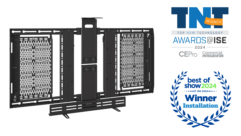AV Specialists Overcoming Obstacles to Fiber Success
Oct 25, 2006 8:00 AM
Although fiber-optic networks often offer the ideal transmission vehicle for high-end audiovisual and multimedia content, a number of practical considerations can also limit the AV integrator’s ability to take advantage of fiber’s benefits. Indeed, newcomers to fiber are challenged both to expand their fundamental knowledge and to match the right fiber strategy and products to their needs.
Several powerful AV industry trends contribute to this situation—chiefly, the broad move to high-definition video for such bread-and-butter applications as conferencing. Video and audio quality once associated with digital cinema and home theater are now turning up in conference rooms all over the world.
Virtual presence and other hot new videoconferencing tools require both high-definition images and high refresh rates—and that means lots of data-handling capacity on the network. This requirement has led many users to fiber, especially for transmitting data over longer distances.
For a long time, though, the real obstacle to achieving these high data rates was not in the fiber itself but in the equipment required at either end. As Extron Electronics, for example, points out in an online guide to AV cables, “System limitations are introduced by the technical restraints of the transmitting and receiving equipment. Existing technology is not capable of reliably sending and receiving the high-resolution, high-frequency computer video information that is commonly seen throughout the AV industry.”
This situation is changing, though, as Extron and other companies introduce new transmitters, receivers and “extenders” that support full Digital Visual Interface (DVI) connectivity. These devices accept digital or analog inputs and convert them into pulses of light rather than the electrical energy that passes through conventional cables. A laser diode then provides the energy to drive this data through the fiber, often over very long distances.
Thinklogical, which is also marketing a line of DVI video extenders for fiber systems, notes two factors, among others, that have chiefly driven the growing use of fiber optics in linking data sources to displays. One is the advent of high-resolution digital flatpanel displays, which can offer higher resolution and truer color fidelity than analog CRT monitors.
At the same time, these displays are often found increasingly far away from their signal sources. Once source and display are more than a few feet apart, the potential arises for a variety of signal losses, degradations, and other problems that can affect the quality of the image displayed. The company says, “DVI extenders allow you to take full advantage of the superior image quality of digital displays even if they are long distances away.”
Increasing distances, such as those found in a stadium, airport, or university campus setting, also change the type of fiber the integrator should consider, or may encounter already installed. In general, multimode fiber (which can transmit more than one wave) is often found within single buildings and other areas where transmission distances are around 1,000ft. at most. For longer hauls—up to 20 miles, single-mode fibers are more commonly used.










